“Climbing to the top demands strength, whether it is Mount Everest or the top of your career.” – A.P.J. Abdul Kalam.
Engagement in this arduous struggle against the highest mountains weaves into our collective narrative, diminishing yet uplifting our essence. Globally, the imposing highest peaks emerge as embodiments of the natural world’s sublime magnificence.
My fascination has always gravitated toward the solitude of the highest mountains, where echoes of antiquity merge with the immediacies of today. Within the Himalayas rest the foremost 10 of these colossuses, each surpassing the next in their lofty splendor. The call of the highest mountain ranges resonates, yet so does the reverberation of the lives they’ve claimed, as much as the sagas of triumph. Nanga Parbat’s somber legacy, K2’s notorious descent, and Everest’s sought-after summits lure the most courageous, aspiring for the zenith of the highest summit elevations.
Key Takeaways
- The Himalayas host the 10 tallest mountains in the world, exemplifying nature’s grandeur.
- These sky-high summits are also known as the ‘eight-thousanders,’ a club of mountains above 8,000 meters.
- Nanga Parbat’s grim reputation is underscored by a high fatality rate, in contrast to Everest’s numerous successful ascents.
- Despite its proximity to Everest, Lhotse remains one of Nepal’s least summited high peaks.
- K2’s daunting challenge is reflected in its fatality ratio, a sobering reminder to all climbers.
- Despite its dangers, Mount Everest remains a popular destination with a hefty price tag for climbing permits.
Understanding Mountain Elevation and Prominence
Mountain geography delves into the complexity of summit elevations through elevation and prominence. These metrics elucidate the scale and magnitude of the planet’s most monumental mountain peaks. They unveil not solely their towering heights but also their dominance over the adjacent terrain.
Defining Elevation: Sea Level to Summit
The elevation of mountain peaks denotes the peak height above sea level, a universally accepted baseline. This vital statistic enhances comprehension of mountainous terrains. For instance, Mauna Kea’s elevation reaches an extraordinary 13,796 feet (4205 m), exemplifying such grandeur.
Topographic Prominence Explained
Prominence signifies the peak’s height relative to the lowest encompassing elevation. Consider Mauna Loa’s prominence at 7,079 feet versus K2’s at 13,179 feet, highlighting K2’s eminent isolation over its surrounding landscape.
Challenges of Accurate Mountain Height Measurement
Numerous technological barriers prevent the accurate determination of summit elevations. Distinctions arise between dry prominence, which ignores the influence of water bodies, and wet prominence, which incorporates them. Remarkably, Mount Everest’s South Summit illustrates minimal prominence at 33 feet, affected by proximate superior elevations.
Accurate measurements of elevation and prominence bestow profound significance upon statistics related to topographical features. Utah’s Kings Peak stands preeminent at 13,528 feet. Similarly, the Matterhorn reaches 14,692 feet but sustains a prominence of 3,419 feet amidst the vast Alps. These figures underscore the imperative of current and precise topographic data. This endeavor is led by entities such as the USGS, exemplified by their revision of Denali’s elevation, which represents an ongoing refinement of our terrestrial topographic records.
Surveying the World’s Tallest Peaks
The chronicle of cataloging and gauging the tallest summits globally is a narrative rife with human persistence. A mere 44 audacious souls have surmounted the apex elevation of each of Earth’s 14 towering peaks surpassing 8,000 meters. These behemoths, stationed within the resplendent Himalayan and Karakoram ranges, are the ultimate mountaineering aspiration.
Discerning a mountain’s highest point—a pinnacle representing the zenith of an ascent—commands unparalleled attention today. Eberhard Jurgalski, ensconced in southwest Germany, commits his existence to documenting climbers’ monumental achievements at these summits. Notwithstanding the rigorous efforts of Jurgalski and his colleagues, skepticism prevails regarding whether the true zeniths of all 14 8,000-meter summits have been trespassed by climbers.
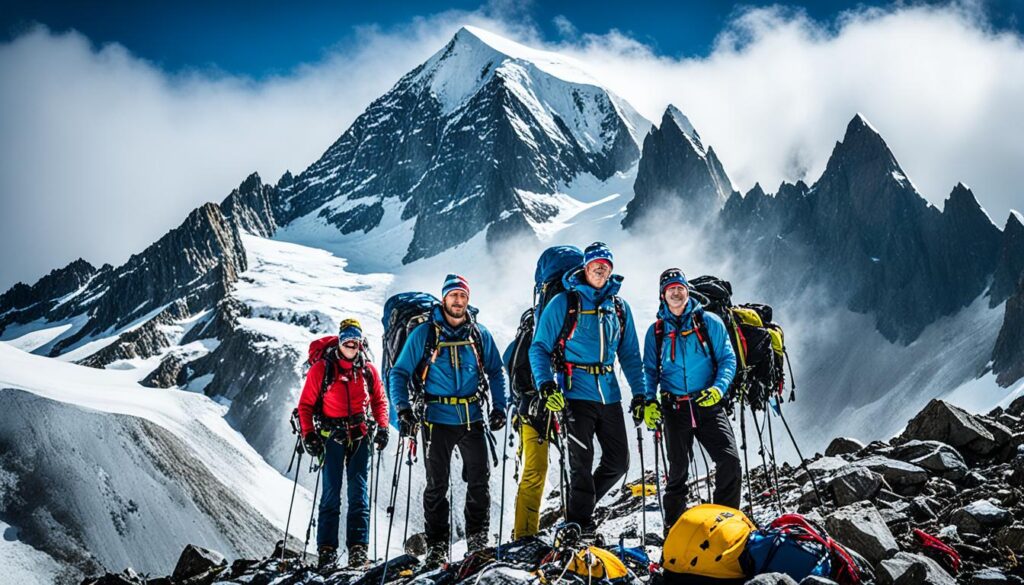
Within these mountain ranges dwells a wealth of narratives about humanity’s triumphs amidst the harshest climes. Yet, this saga is nuanced, continually molded by ongoing scrutinies into previous elevation claims, hence throwing previous conquests into question. Through meticulous examination of photographs and narratives, Jurgalski and volunteers aspire to confirm climbers’ irrefutability in attaining genuine summits.
| Mountain Range | Total 8,000-meter Peaks | Climbers Achieving All Summits | Potential Unreached Summits |
|---|---|---|---|
| Himalayas | 10 | 44 | Uncertain |
| Karakoram | 4 | 44 | Uncertain |
These elevation records transcend mere historical annotations or the fleeting elation of a summit badge; they epitomize the relentless resolve of explorers to conquer the formidable bastions of nature. Concurrently, as we delineate, we contemplate the import of the summit, urging alpinists to redefine triumph. Triumph should not be confined to attaining the highest locus but should treasure the quintessence of voyages and the sanctity of these monolithic entities.
Verily, the odyssey to meticulously map the world’s tallest summits symbolizes a fusion—of human ambition and the earnest quest for veracity amid our planet’s most majestic global peaks.
The Himalayan Giants: Home to the Highest Summits
As a mountaineer of considerable experience, my fascination has invariably gravitated towards the Himalayas. This region, eminent for containing some of the highest mountain summits globally, holds a magnetic attraction. Located in Asia, it captivates those keen on exploring or marveling at its vast peaks. Its pinnacle, Mount Everest, is a colossus between Nepal and China, epitomizing Earth’s magnificence. Towering at 29,035 feet, it beckons adventurers and raconteurs, those desiring to partake in its grandeur or narrate the valorous exploits of its conquerors.
In 2019, testament to Everest’s undiminished appeal, the Nepali authority sanctioned a record 381 permits. This act underscores not only Everest’s attraction but also the indomitable human spirit to surmount the tallest peaks. Yet, Everest’s story is merely one scene in a broader epic spanning the highest mountain ranges. This narrative also encompasses formidable giants such as Kangchenjunga, Lhotse, and Makalu.
Mount Everest: The Highest Point on Earth
Mount Everest often occupies a central position within the discourse on sublime summits due to its paramount elevation and the formidable challenges it imposes on climbers. Its unmatched preeminence in mountaineering attracts individuals yearning for the thrill of surmounting the highest mountain ranges known.
Mount Everest climbs embody narratives of human resilience and transcendence, emphasizing that the region represents more than just one peak’s story.
Kangchenjunga: The Majestic Ruler of the Skies
Kangchenjunga, marking the demarcation between Nepal and India, stands not only as a behemoth but also a spectacle of nature. As the third-highest mountain, it reaches an elevation of 28,169 feet, celebrated for its stunning beauty and the daunting challenges it presents to climbers.
Lhotse and Makalu: Everest’s Formidable Neighbors
Adjacent to Everest, Lhotse, and Makalu are eminent figures within this lofty family. Lhotse, peaking at 27,940 feet, is often regarded as Everest’s formidable affiliate due to its closeness. Meanwhile, Makalu, with its unique four-sided pyramid stature, peaks at 27,838 feet, reinforcing the Himalayas’ status as the domicile of the tallest peaks.
Delving into the vastness of these Himalayan giants unfolds more than mere ascents; it unveils insights into Earth’s highest spirits. Such journeys continue to enchant those who gaze skyward, yearning for adventure amongst the planet’s highest summits.
Panoramic Views from the Karakoram: Pakistan’s Prized Ranges
The Karakoram range, distinguished within the echelons of prominent global mountain ranges, boasts towering summits that magnetize mountaineers and adventurers. My expeditions through these elevated landscapes have incessantly disclosed a realm epitomizing sheer grandeur.

The epitome of the Karakoram’s majesty, K2, soars at a remarkable altitude record of 8,611 meters, straddling the China-Pakistan frontier. It embodies a duality of awe and peril, demanding veneration beyond its sheer elevation due to the formidable climbing obstacles it presents. This colossal alpine peak transcends its geographical categorization, symbolizing the zenith of human aspiration and resilience.
While renowned for its alpine peaks, the Karakoram narrates tales of human tenacity. Each elevated landscape narrates the endurance and resolve required to surmount these majestic edifices. Climbers globally aspire to inscribe their legacy within the mountaineering annals by conquering these altitude records. Adjacent giants like Gasherbrum I and Broad Peak further enhance the range’s illustrious repute amid prominent mountain ranges.
In my quest to encapsulate the Karakoram range, I stand perpetually awestruck by the mute chronicles these towering summits harbor. Within these heights lie stories of triumph and despair, echoing profoundly with anyone harboring a deep-seated enchantment for the wilderness.
Discovering the Highest Mountains Beyond Asia
My journey to illuminate the tallest mountain ranges transcends the familiar Asian terrains, highlighting the highest mountain outside Asia amidst other towering mountains that assert their dominance across diverse continents. This quest to scale such majestic summits uncovers not merely altitudes; it divulges the grandeur of varied ecosystems, their cultural import, and the enduring legacy of mountaineering globally.
Aconcagua: The Andean Behemoth
My exploration commenced with Aconcagua, the Andean behemoth, recognized as the highest mountain outside Asia. Rising to 6,961 meters (22,838 feet), this mountain not only represents South America’s zenith but also claims the distinction as the tallest peak across the Western and Southern Hemispheres. Amidst the most prominent of tallest mountain ranges, the Andes offer trekkers breathtaking vistas alongside an opportunity to journey through paths rich in ancient civilizations and vibrant biodiversity.
Denali: North America’s Snow-capped Monarch
Progressing north, I encountered the regal Denali. At 6,190 meters (20,310 feet), it stands as North America’s gem, with a dramatic elevation gain that signifies one of the most challenging ascents. Beyond its physical stature as the highest mountain outside Asia, Denali’s extensive snow-clad panorama epitomizes Alaska’s wilderness and adventure, elevating it among the most formidable towering mountains.
Kilimanjaro: The Rooftop of Africa
In Africa, the iconic Kilimanjaro awaited with its volcanic trio. Kilimanjaro soars to 5,895 meters (19,341 feet), reigning as Africa’s highest mountain and a marvel of nature. At Uhuru Peak, trekkers reach what is celebrated as ‘The Rooftop of Africa,’ embodying the unyielding spirit of both explorers and the indigenous peoples who hold this peak in reverence amidst one of the tallest mountain ranges.
My admiration for these natural monuments has only intensified with each expedition, from Aconcagua’s wind-swept peaks to Denali’s icy challenges and Kilimanjaro’s majestic ascent. They stand as monoliths of Earth’s geological prowess, beckoning adventurers and nature enthusiasts to surpass ordinary limits and aspire to the celestial.
The Significance of the Seven Summits
The 7 summits represent the zenith of mountain climbing expeditions across continents, transcending mere geographical milestones. They epitomize the quintessence of human tenacity and the embodiment of the adventurous spirit. This endeavor is not solely a matter of mapping physical geography. Rather, it symbolizes the pinnacle of what humans can achieve through perseverance and indomitable will.
Last month’s tragedy on Mount Everest, where at least 11 climbers, including two Americans aiming for the Seven Summits Club, succumbed, underscores the peril inherent in such quests. These fatalities remind us that the endeavor to scale these peaks records the physical heights and the immense human sacrifices made. The loss of life is a sad recognition of the costs associated with this high-stakes ambition.
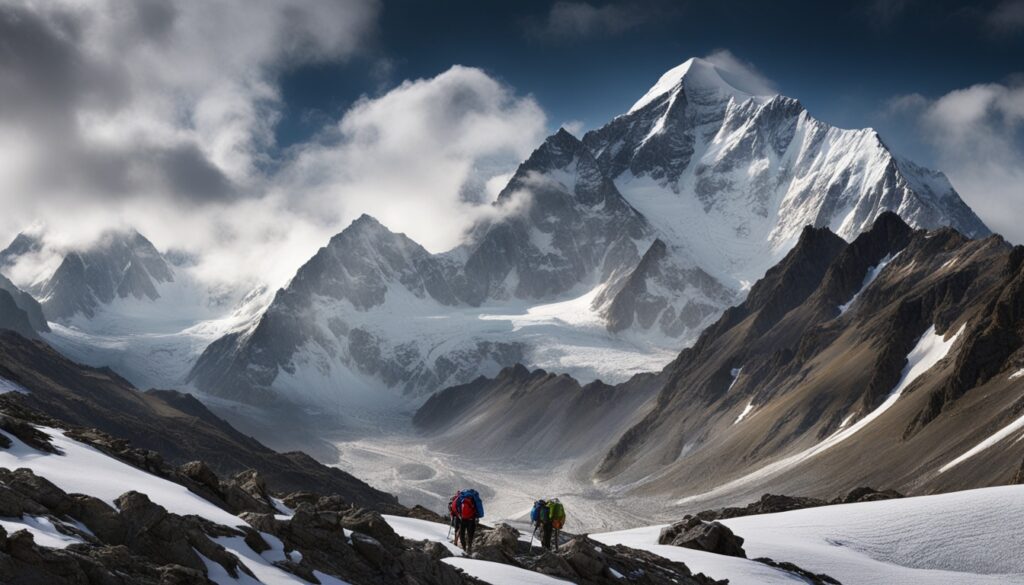
The narratives of Christopher Kulish and Donald Cash, who met their demise post-Everest ascent, highlight the inherent risks of summiting the globe’s tallest mountains. Their stories, amid reports of extreme congestion that saw nearly 250 climbers simultaneously ascending Everest, illustrate the dangers lurking in these formidable endeavors. This tragic dimension emphasizes the perilous nature of such achievements.
The inception of the Seven Summits was marked by Richard Bass’s pioneering completion in 1985. Presently, the Seven Summits quest involves scaling peaks like Denali, Aconcagua, and Everest. These mountains represent the apex of each continent, continuing to draw adventurers worldwide to this illustrious climbing circuit.
Embarking on a Global Mountaineering Quest
The diversity of adventurers pursuing the Seven Summits is vast. David Mauro’s initiation into this elite circle began in 2007 with Denali, setting him on a path that would traverse the globe. In contrast, Alison Levine led an all-woman team to Everest in 2002, showcasing physical and leadership prowess. Her accomplishment, completing the Seven Summits, underscores the exigence of stringent safety measures and vigilant leadership.
Diverging Lists of World’s Highest Peaks by Continent
Controversy surrounds the definitive list of the Seven Summits. Renowned mountaineer Reinhold Messner proposed an alternative list, including Puncak Jaya, illustrating the subjective nature of such classifications. These divergent perspectives reveal a collective yearning to engage with mountains beyond their physicality, probing into their historical, geographical, and climatic significance.
As articulated by climbers like Alison Levine, the essence of the Seven Summits challenge transcends the act of summiting. It reflects the journey’s intrinsic value—transformative experiences, personal growth, and the resilience developed beyond mere physical conquests. These experiences shape the climber, fostering enduring connections beyond the heights conquered.
The Mighty ‘Eight-Thousanders’: A Mountaineer’s Ultimate Achievement
The eight thousand peaks, embodying the zenith of nature’s majesty and human resolve, constitute the planet’s premier mountain peaks. Nestled within the Karakoram and Himalayan chains, these fourteen titans challenge the bravest, with triumphs reserved for a select few.
The pathway to the eight-thousanders’ summits is riddled with peril, underscored by the mortality rates of Annapurna, K2, and Nanga Parbat. Annapurna, with a death toll exceeding 30 percent, epitomizes the ultimate mountaineering hazard.
Mount Everest, while iconic, annually records fatalities, underscoring a high risk yet significant to the mountaineering ethos. Here, climbers pay tribute to precedents, acknowledging the evolving dynamic between humanity and the formidable natural world.
Exploring high-altitude mountaineering, one admires Reinhold Messner, who first conquered all fourteen eight-thousanders. Achieving this over 16 years, he marked a milestone replicated by merely 31 climbers, distinguished by unwavering perseverance.
Contrastingly, Shisha Pangma offers a glimmer of hope among these giants as the accessible pinnacle yet bears the sorrow of 25 souls perished by March 2012, underscoring its latent challenge.
Turning to the underrated yet daunting Gasherbrum II near K2, it is a formidable venture, representing the quintessence of high-altitude mountaineering.
In summary, the quest for the eight thousand transcends physicality, evolving into spiritual odysseys. This pursuit compels climbers to confront the void, uncovering the profound essence of mountaineering valor.
Highest Mountains and Their Climbing Histories
The chronicle of mountain climbing history thrives on a series of first ascents and courageous pioneering expeditions, crafting our intricate bond with Earth’s imposing natural edifices. Far from a simple recounting of dominance over nature, each story weaves into the broader historical milieu. It encompasses seminal historic climbing achievements such as the initial successful ascent of Mount Everest and the mastery over K2’s perilous inclines. These pivotal moments transcend ordinary historical annotations, embodying the indomitable human desire to surmount the seemingly impossible.
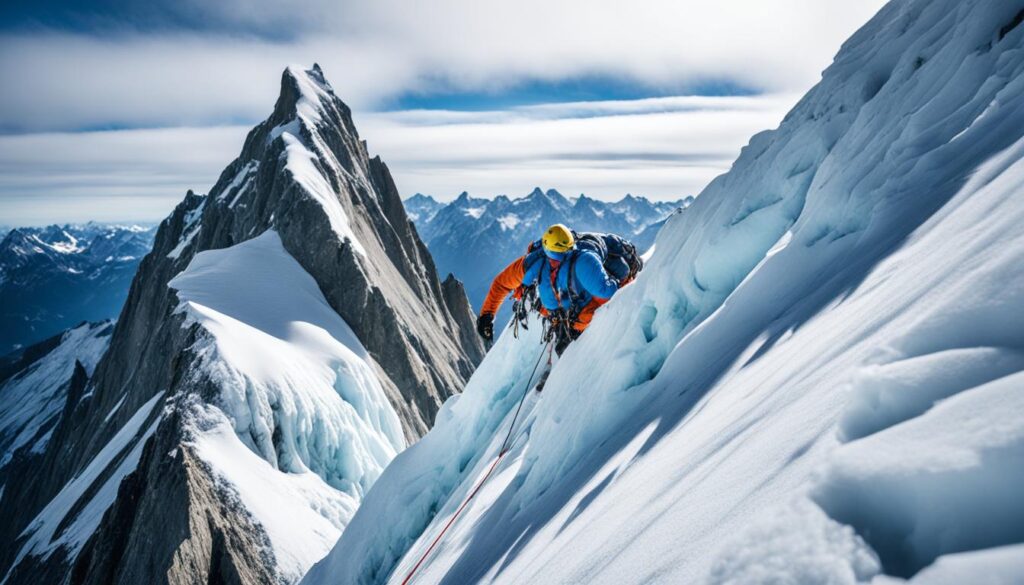
First Ascents and Pioneering Expeditions
The year 1953 emerges distinctly in the annals of mountaineering, highlighted by Sir Edmund Hillary and Tenzing Norgay’s victory atop Mount Everest, positioned at the precipice between Nepal and China at 29,035 feet. This seminal event paved the way for Achille Compagnoni and Lino Lacedelli’s 1954 ascent of K2. In the ensuing years, the allure of these majestic peaks swelled, with Mount Denali and Kilimanjaro claiming their places in the lore of North American and African climbing history, respectively.
Historical Perspectives on Top Climbing Destinations
Certain mountains, like Mount Elbrus in Russia and the Matterhorn in Switzerland, have ascended to mythic status. These giants are celebrated for their sheer scale and their profound impact on climbing heritage. Serving as Europe’s bastion, Elbrus, and emblematic of famous mountains and alpinism, the Matterhorn relays their distinct sagas. Moreover, the Andes, reflecting ascent history via the Inca Trail and the culturally vibrant Annapurna region in Nepal, amplify the global climbing narrative. These sites extend beyond mere altitudes; they provide insights into the evolution of expedition tactics and the unwavering spirit of human endeavor.
| Mountain | Location | Height | Notable Fact |
|---|---|---|---|
| Mount Everest | Nepal-China Border | 29,035 feet | Record 381 permits issued in 2019 |
| Mount Denali | Alaska, USA | 20,320 feet | Highest in North America |
| Kilimanjaro | Tanzania | 19,340 feet | Highest in Africa |
| Mount Elbrus | Russia | Watchtower of the Caucasus | Highest in Europe |
| The Matterhorn | Switzerland | Symbolizes traditional mountaineering | One of Europe’s most recognized |
Exploring the Interplay: Mountain Geography and Climatology
Initiating a profound discourse on the interplay between mountain geography and climatology reveals an intricate narrative between terrestrial forms and meteorological phenomena. The Rocky Mountains, traversing from Canada’s British Columbia through to New Mexico, serve as a paramount example, illustrating the grandiosity of mountainous ranges within North America. Contrarily, the Sierra Madre range, characterized by its volcanic apexes reaching elevations up to 5,636 meters, elucidates distinct climatic patterns inherent to alpine regions of extreme elevation.
Consider the Cascade Range, manifesting Earth’s nascent topographical forms, emerging with volcanic fervor scarcely a million years ago. Enveloped by a temperate rainforest, it absorbs 254 to 508 centimeters of precipitation annually, integrating a verdant paradigm into North America’s geographic mosaic, thereby altering local mountain climatology.
The Great Plains presents a stark dichotomy, dominated by extensive grasslands—the largest biome in North America—and inhabited by indigenous fauna such as bison and prairie dogs. This expansive territory’s climactic disposition diverges significantly from mountainous landscapes, where extreme elevations nurture tundra biomes, exemplified by Canada’s Shield region with its underpinning permafrost.
- Atlantic Coastal Plain Wetlands: encompassing ecosystems such as the Florida Everglades, extending over 11,137 square kilometers.
- Caribbean Marine Diversity: showcasing coral reefs and cays bursting with tropical marine life, epitomizing the biodiversity prevailing under specified climatic conditions.
- Denali’s Peak: Marking the zenith of North America at 6,194 meters, epitomizing the climatic severities at soaring altitudes.
- Ancient Greece’s Mountainous Influence: Eighty percent of its terrain is enveloped by rugged landscapes and seminal summits like Mount Olympus, which influenced ancient civilizations in conjunction with climate.
Mountain climbers and geographers heed the diverse climates—contrasting the temperate milieu of the Atlantic coastal plains with their extensive wetlands against the life flourishing in the coral-rich Caribbean waters. Extreme elevations and topographical summits are instrumental in molding these climates, with Denali and ancient Greece’s Mount Olympus as quintessential exemplars.
Explorations from the Great Lakes, the global paramount freshwater repository, to the historic Pindus Range threading through Greece manifest the symbiosis of climatology and topography. From the Mediterranean’s amiable clime, which nurtured ancient civilizations, to the trade winds and cultural exchanges across the Ionian and Aegean seas, each scenario elucidates an epoch of both anthropogenic and natural histories, intricately shaped by the distinctive attributes of its terrain and atmospheric systems.
Unique Topographical Features of Towering Summits
In my ventures as a mountaineer, I have undertaken extensive studies of the Earth’s surface, festooned with topographical features. From the Himalayas’ mountain peaks to the Andes’ alpine elevations, these regions showcase a mesmerizing landscape variety. These distinguishing characteristics shape our planet’s exterior and encapsulate the chronicles of its geological evolution. The Earth’s dynamism is heralded by fourteen notable summits surpassing 8,000 meters, manifesting the planet’s vigorous dynamism.
The Distinction Between Peak and Mountain
The nuances distinguishing a peak from a mountain are essential for comprehending elevated terrain. A peak signifies the zenith, an ultimate point avidly pursued by climbers for its commanding perspective. In contrast, a mountain denotes considerable bulk, potentially comprising several lesser peaks within its expanse. Notably, the Karakoram and Himalayas harbor eminent summits such as Annapurna and K2, symbolizing the intoxicating beauty and hazards inherent at these peak altitudes.
Studying the Shape of the Land: Plateaus, Ridges, and Gorges
Map contour lines unveil altitudes while depicting the distinct profiles of plateaus, ridges, and gorges, forming the essence of alpine elevations together. The Kaligandaki Gorge, situated amidst Nepalese colossi, claims the title of one of Earth’s deepest gorges. Such landforms and interconnected ridges render a skeletal outline of the Earth’s crust, elucidating the forces that molded our planet’s most elevated terrain.
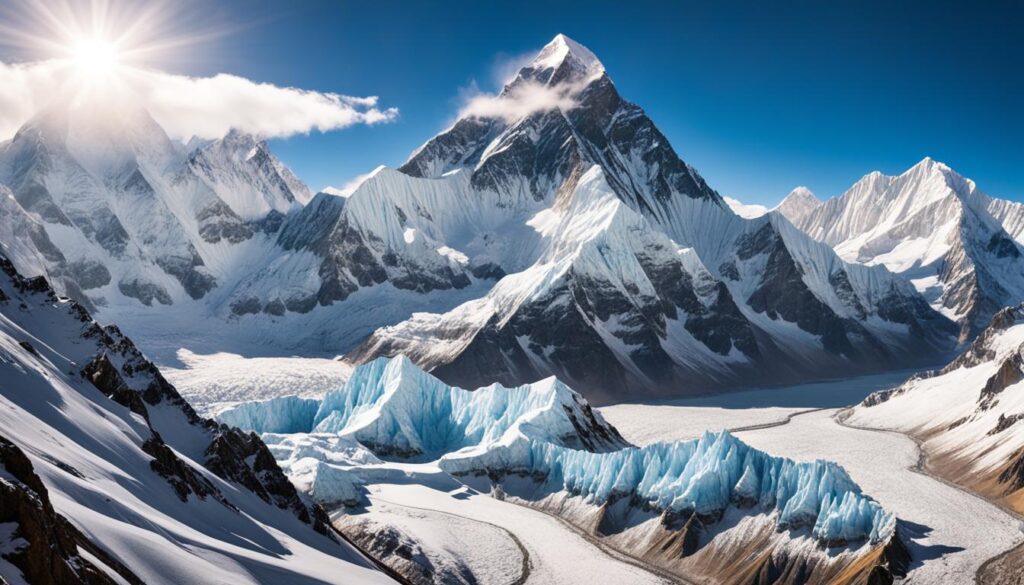
Both victory and sorrow mark the narratives surrounding these grand summits. Expeditions to high-altitude strongholds, including Annapurna, with a daunting mortality rate of over 30%, and Mount Everest’s peak at 8.8 kilometers, inhabit the annals of mountaineering lore. These harsh realities—where nature claims one life for every four achievements on certain ascents—underscore nature’s solemn might and our unending allure towards these topographical features.
While modern technology like synthetic aperture radar improves our comprehension of these summits, discoveries like marine fossils on Everest, once submerged beneath an ancient sea, underline the entwinement of time, existence, and continental drift. This serves as a poignant reminder that our present cartography offers merely a glimpse into landscapes perpetually reshaped by subterranean titanic forces.
Challenges and Dangers of High-Altitude Climbing
For enthusiasts attracted to the formidable challenge of high-altitude climbing, scaling the world’s highest peaks presents a juxtaposition of allure and formidable challenge. These endeavors encompass risks, rendering summit achievements a testament to climbers’ prowess, will, and deep environmental comprehension.
The narrative of my climbing expeditions often invokes inquiries concerning the treacherous terrain and volatile elements emblematic of high-altitude exploration. Participants confront rugged landscapes, where fidelity to the precarious mountaineering paths delineates the boundary between victory and misfortune.
Navigating Treacherous Terrain and Extreme Weather
The concept of ‘treacherous terrain’ materializes on glaciated fronts where secure foot placement is paramount. In these realms, climbers grapple with diminishing oxygen levels, each step on frost-bound inclines necessitating experiential equilibrium. The capriciousness of weather introduces an unpredictable adversary capable of swiftly mutating from tranquility to tempest, confronting climbers with sudden blizzards that test their fortitude.
Understanding Altitude Sickness and Acclimatization
Altitude sickness emerges as a stealthy yet formidable foe, impartial to climbers’ experience levels. Escalating altitudes provoke symptoms ranging from benign (itching and skin redness) to dangerous (breathing difficulties and anaphylaxis), akin to altitude sickness in their manifestation of nausea and vomiting.

Acclimatization represents a critical, albeit arduous, natural adjustment to reduced oxygen availability at high elevations. This process is essential for reducing altitude sickness risk, permitting climbers to endure the rarified atmosphere—an adaptation fostered by time and necessitated by prudence.
High-altitude climbing epitomizes an education in the extremes of physical and mental endurance. These formidable peaks serve as unparalleled instructors in the resilience of body and spirit. Integral to successful ascents is profound knowledge concerning altitude sickness and acclimatization, alongside a deep-seated reverence for the mountain’s majesty.
| Risk Factor | Detail | Related to High-Altitude Climbing |
|---|---|---|
| Severe Weather | Rapid, unpredictable changes | Increases risk of frostbite and hypothermia |
| Treacherous Terrain | Ice-covered slopes, crevasses | Necessitates precise navigation and gear |
| Altitude Sickness | Caused by decreased oxygen levels | Proper acclimatization practices can mitigate this |
| Anaphylaxis (Altitude Sickness) | Symptoms mimic severe allergic reactions | Requires immediate medical intervention |
Ascending the majestic expanse that towers above terrestrial ordinaries presupposes a delicate amalgam of corporeal strength and cerebral steadfastness. While the mountain’s impartiality remains unchallenged, its role in shaping the climber’s psyche—instilling humility and resilience—is indisputable. High-altitude climbing transcends physical conquest, challenging human potentiality and redefining the boundaries of possibility.
The Future of Mountain Exploration: Unclimbed Summits
Pursuing mountain exploration has perennially drawn humanity toward the majestic and unknown. The allure of unclimbed summits magnetizes today’s climbers. These pristine peaks stand as symbols of adventure and embody the evolving lore of mountaineering. They represent the untapped apexes yet to be conquered, poised to redefine the trajectory of this daring endeavor.
Statistics shed light on the undiminished zeal for conquering the world’s towering heights. In 2021, the Nepal Ministry of Tourism issued a record 408 Everest permits. This occurs despite the daunting acknowledgment that 1% of climbers may fall victim to the mountain, with a mortality rate of 1.2%. The period between 2000 and 2018 saw 7,990 climbers summit Everest, juxtaposed against 123 fatalities—a testament to the inherent risks. The economic impact is significant; Everest climbing permits generated $5.2 million for Nepal in 2018 alone. The reliance on supplemental oxygen underscores the extreme challenges of high-altitude climbing.
| Year | Everest Permits Issued | Death Rate on Everest | Revenue from Permits (USD) |
|---|---|---|---|
| 2021 | 408 | 1.2% | Not Available |
| 2000-2018 | Not Specific | 1.5% | 5.2 million (2018) |
Mountaineering’s frontier is vast, harboring untold numbers of summits untouched by human presence. The inaugural ascent of Mt. Ilse in the Southern Patagonian Ice Field revealed that only its companion peak had been scaled. Patagonia’s exploration indicates that a third of its peaks are virgin territory. It is a landscape with granite monoliths and alpine faces, unchallenged and majestic, inviting the bold.
Features like Mt. San Valentin’s 3000-meter north face encapsulate the essence of alpine innovation. These hitherto unexplored domains promise to usher in a golden age of mountaineering. To traverse them requires not just the patience of bygone explorers but also advanced technical prowess and an insatiable curiosity to venture into the unknown. The countless unnamed peaks, presenting intricate routes and ecological riddles, are the guardians of mountaineering’s future.
The explorers navigating these uncharted terrains may be amongst us or yet to arise. However, mountaineering thrives on a legacy of shared ambition and collective endeavor. The opportunity to pioneer is not exclusive to seasoned alpinists but extends to anyone endowed with the valor, determination, and vision to venture beyond known boundaries. It is an invitation to confront the unclimbed, to step into the untouched wilderness.
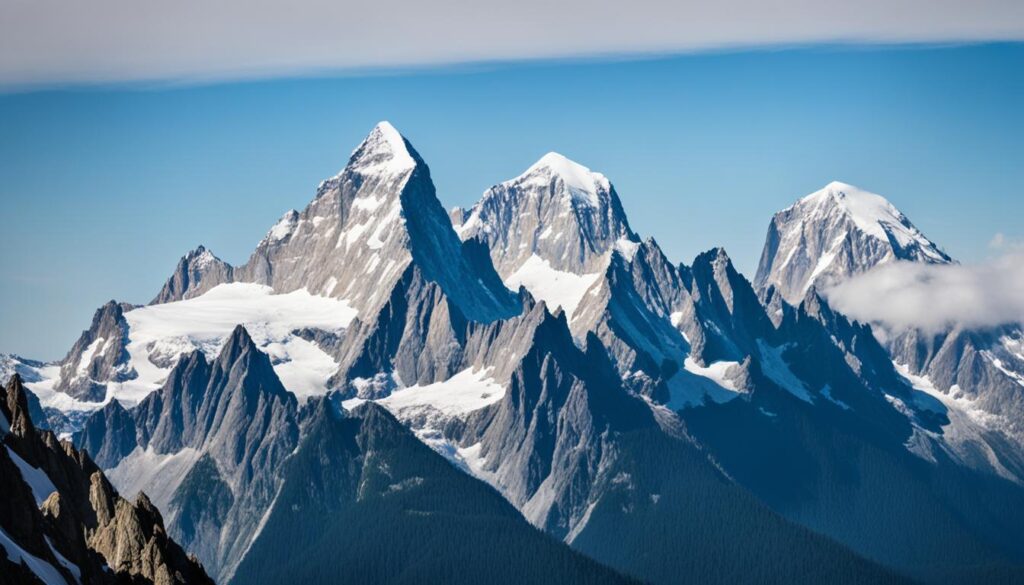
“The thrill of mountain exploration is not found in the triumph of reaching a summit alone but in the journey towards realms yet untouched by humankind.”
The quintessence of mountaineering is preserved in the relentless pursuit of exploration. It compels us to press onward, to scale new heights, and to dare to envisage the peaks that defiantly await their first conquerors.
Final Thoughts
Reflecting upon the earth’s surface reveals the highest mountains as awe-inspiring testaments to nature’s grandiosity. Within the Himalayas, thirty preeminent peaks, including Mount Everest, beckon climbers and adventurers to their formidable summits. Everest, ascending to 29,035 feet, epitomizes a climber’s paramount achievement and a formidable challenge. Beyond their climbing accolades, these elevations critically shape global borders, modulate weather patterns, and exert profound environmental influences. Their range is extensive from Mount Davis in Pennsylvania’s panoramic views to the agricultural and water resource impacts of glacial runoff.
Personal mountaineering endeavors highlight mountain trekking’s transformational essence, charting a journey of self-discovery. This venture transcends mere adventure, unveiling an educational saga on environmental shifts, evidenced by the burgeoning glacier lakes and permafrost’s waning stability. Glaciers, indicators of climatic alterations, impinge upon local wildlife and the solidity of adventurers’ paths. The intricately woven tapestry of life, reliant on these icy bastions, underscores the imperative of maintaining ecological equilibrium.
The precipice of the future extends an invitation for climbing pursuits intertwined with ecological reverence and sustainability. Witnessing the repercussions of human activities on the cryosphere and alpine ecosystems enlightens the necessity for climbers’ ambitions to converge with conservation efforts. Amidst towering mountains, a narrative of human aspiration coalesces with the duty to preserve revered landscapes. Engaging in trekking, climbing, and exploration signifies enrolling in an enduring adventure narrative committed to protecting alpine domains for forthcoming voyagers.
FAQ
What is the highest mountain in the world?
How is mountain elevation measured?
What is topographic prominence?
Why do mountain elevation measurements vary?
How have mountain surveys evolved?
Besides Mount Everest, which are the other tallest mountains in the Himalayas?
What are the tallest mountains in the Karakoram range?
What are the highest mountains outside of Asia?
What are the significance and criteria of the Seven Summits?
What is ‘Eight-Thousanders’, and how many are there?
How do mountain geological features affect climbing?
What are the main challenges faced in high-altitude climbing?
What opportunities do unclimbed summits present to mountaineers?
Source Links
- https://www.livescience.com/29627-world-highest-mountain-summits.html
- https://www.worldatlas.com/articles/how-is-topographic-prominence-different-from-the-actual-elevation-of-a-summit-above-sea-level.html
- https://www.utah.com/articles/post/9-highest-peaks-across-utah/
- https://www.usgs.gov/communications-and-publishing/news/earthword-prominence
- https://www.nytimes.com/interactive/2021/sports/tallest-mountain-summit.html
- https://www.nationalgeographic.com/travel/article/climbs
- https://timesofindia.indiatimes.com/travel/travel-news/international-mountain-day-2023-worlds-top-5-highest-mountains/articleshow/105898459.cms
- https://www.nature.com/articles/s41467-021-23073-4
- https://www.npr.org/2019/06/05/728761498/the-summit-is-never-the-goal-why-climbers-pursue-the-7-summits
- https://www.earthobservatory.nasa.gov/features/8000MeterPeaks
- https://www.nationalgeographic.org/encyclopedia/north-america-physical-geography/
- https://www.historyforkids.net/geography-of-ancient-greece.html
- https://www.honolulu.hawaii.edu/instruct/natsci/geology/brill/gg101/Programs/program8 MountainBuilding/program8.html
- https://www.mayoclinic.org/diseases-conditions/altitude-sickness/symptoms-causes/syc-20374285
- https://www.nationalgeographic.com/adventure/article/climbing-mount-everest-1
- https://alpinist.com/features/living-maps-of-patagonia-toward-a-new-future-of-exploration/
- https://www.nationalgeographic.com/science/article/mountains
- https://www.abc27.com/news/top-stories/highest-mountains-in-pennsylvania/
- https://www.ipcc.ch/srocc/chapter/chapter-2/
